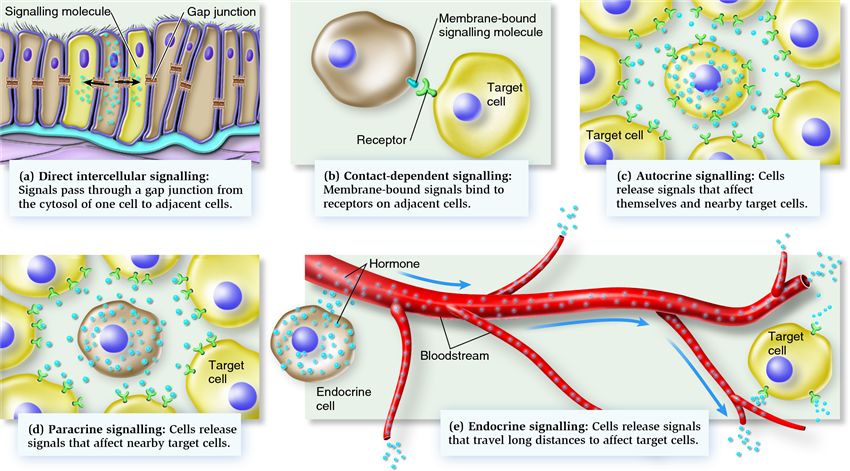 |
| Previous Image | Next Image |
| Description: Direct Intercellular Signalling In a multicellular organism, cells that are adjacent may have contacts, called cell junctions, that enable them to pass signalling molecules and other materials between the cytosol of one cell and the cytosol of another. For example, in many tissues adjacent cells communicate with one another through intracellular connections known as gap junctions. These channels permit the passage of various molecules and ions from one cell to a neighbouring cell and may thereby influence its behaviour. Similarly, plant cells are often connected by junctions known as plasmodesmata. Contact-Dependent Signalling Not all signalling molecules can readily diffuse from one cell to another. Some molecules are bound to the surface of cells and provide a signal to other cells that possess an appropriate receptor. Contact-dependent signalling is exemplified by antibody producing cells, which coordinate antibody production by interacting with one another. Interestingly, the same receptor that permits this interaction is also a target of the capsid protein of the human immunodeficiency virus (HIV), responsible for the disease called acquired immune deficiency syndrome (AIDS). This allows the AIDS virus to select such cells for infection, often culminating in the demise of that cell type and the loss of immunological protection. Autocrine Signalling In autocrine signalling, a cell secretes signalling molecules that bind to receptors on its own cell surface, stimulating a response. In addition, the signalling molecule can affect neighbouring cells of the same cell type. Autocrine signalling is often important for groups of cells to sense cell density. When cell density is high, the concentration of autocrine signals is also high. In some cases such signals will inhibit further cell growth and thereby prevent the cell density from becoming too high. Paracrine Signalling In paracrine signalling, a specific cell secretes a signalling molecule that does not affect the cell secreting the signal, but it does influence the behaviour of target cells in close proximity. Paracrine signalling is typically of short duration. Usually, the signal is broken down too quickly to be carried to other parts of the body and affect distant cells. A specialized form of paracrine signalling called synaptic signalling occurs in the nervous system of animals. Neurotransmittersà ¢â‚¬â€Âmolecules made in nerve cells that transmit a signal to an adjacent cellâ€â€Âare released at the end of the nerve cell and traverse a narrow space called the synapse. The neurotransmitter then binds to a receptor in a target cell. Endocrine Signalling In contrast to the previous mechanisms of cell signalling, endocrine signalling occurs over long distances. In both animals and plants, molecules involved in long-distance signalling are called hormones. They usually last longer than signalling molecules involved in autocrine and paracrine signalling. In animals, endocrine signalling involves the secretion of hormones into the bloodstream that may affect virtually all cells of the body, including those that are far from the cells that secrete the signalling molecules. In plants, hormones move through the vascular system and can also move through adjacent cells. Some hormones are even gases that are secreted into the air. Ethylene is a gas given off by plants that plays a variety of roles, such as the acceleration of fruit ripening. Picture Stats: Views: 2022 Filesize: 91.97kB Height: 471 Width: 850 Source: https://biology-forums.com/index.php?action=gallery;sa=view;id=367 Keywords: Examples of cell-to-cell communication based on the distance between cells |
